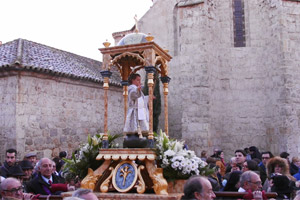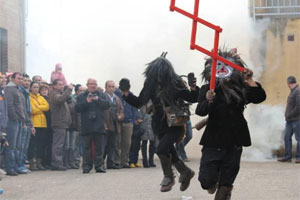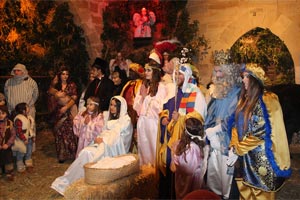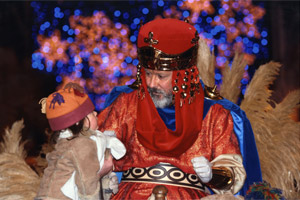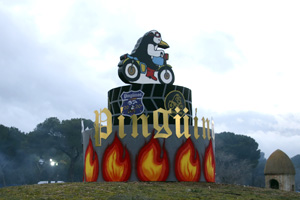Patum de Berga
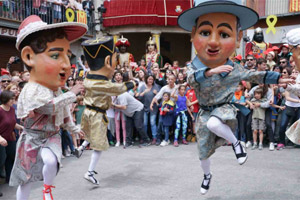
What is Patum de Berga?
Patum de Berga is an iconic traditional event celebrated in the town of Berga, in the province of Barcelona. This festivity takes place during Corpus Week, which is usually celebrated in June. Patum is a festive and cultural manifestation that blends elements of religion and paganism, rooted in the medieval era.
During the celebration, the streets of Berga come alive with music, ancestral dances, and theatrical performances that involve a multitude of participants and attract numerous visitors. The event is characterized by various representations of mystical and symbolic figures that dance to the rhythm of music and drums. The dances stand out for their solemnity and the use of fire and pyrotechnic devices.
The tradition of Patum de Berga dates back to 1454.
On the eve of Corpus Thursday, the Wednesday prior, the "tabal" (the festival announcer) and the giants parade through the city to announce the beginning of the festivities.
Subsequently, the mime drama begins, divided into multiple acts, representing intense battles between Christians and Arabs, the fight of the archangel Saint Michael with the angels against Lucifer and his demons, and the mockery directed at the Arab leader Abul-Afer or Bullafer, the conqueror of the region. On the other hand, the act of the eagle expresses Berga's satisfaction at having been liberated from feudal rule and depending directly on the king.
Main Events of Each Day:
- Wednesday: Midday and evening performances in honor of the authorities.
- Thursday: Patum "display" at midday and Patum "complete" in the evening.
- Friday: Children's Patum at 10:00 AM, Children's Patum "display" at midday, and Children's Patum "complete" in the afternoon.
- Saturday: Ceremony for the honorary titles of "Patumaire" and a new performance in the evening honoring the administrators and squares of Berga.
- Sunday: Patum "display" at midday and Patum "complete" in the evening.
The Comparsas
Each of the dancing figures that are part of the parade, each with its own meaning and different antiquity:
Los Turcos y Caballeros (The Turks and Knights)
This group consists of four Turks with turbans and shining scimitars, carrying wooden horses around their waists. They gather in the center of the square, forming two concentric circles, and a battle begins to the rhythm of specially composed music for this occasion. The Moors constantly chase the horses, which always manage to escape their pursuers. The act concludes with a symbolic stabbing of the Christians by the Moors.
El Tabal (The Drum)
The "timbal" is a central figure in the festivities. This person carries a large drum and proclaims the celebrations. They do this on Ascension Sunday and also on Trinity Sunday. During the Corpus Christi eve, at midday, the drum is played again, this time accompanied by the Giants. It is said that the sound of the drum is what gives the Patum its name. According to tradition, it is believed that the drum has a magical power to disperse the clouds and improve the weather. It is also said that any inhabitant of Berga who is far from the city, regardless of the distance, if they bring their ear close to the ground on Ascension Day, they can hear the sound of the drum.
Mazas (Maces)
In this representation, the devils carry a mace with a whip at the end, dancing in pairs alongside Saint Michael and the Angel. When the mace's firecracker explodes, the devil falls to the ground as if dead. The dance continues until all the devils are defeated and lie on the ground.
Las Guitas (The Guitas)
The Guitas are monstrous creatures with a long dragon-like neck. Their goal is to chase people while shooting fire from the firecrackers in their mouths. Initially, there was only one called "Guita Grossa" (Big Guita), but in the late 19th century, another one known as "Guita Xica" or "Guita boja" (Small Guita or Crazy Guita) was added, which is smaller in size.
El Águila (The Eagle)
L'Aliga, considered the most prominent figure of the Patum, is a symbol of power (represented by the ducal crown it wears) and also carries the coat of arms of Berga. Its dance is elegant and delicate, with fast and slow movements that increase in solemnity to the rhythm of the music, culminating in a quick spin on itself.
Els Nans vells (The Old Nans)
The Nans Vells, also known as the old cabezudos (big heads), perform a dance while playing castanets to the rhythm of waltz music. These characters were added to the Patum in 1855 and each one has a height of 60 cm and a weight of ten kilograms.
Los Gigantes (The Giants)
Within the celebration, there are two pairs of giants: the old giants and the new giants, the latter incorporated in 1891. These impressive figures delight the audience, especially the younger ones, with their magnificent dance.
Els Nans nous (The New Nans)
The nans nous, also known as the new cabezudos, originated in 1888 and represent two pairs, one older and one younger. The music that accompanies them is cheerful and playful in style.
Els Plens (The Plens)
In the Patum festivities, fire is the most prominent element, and els Plens embody the infernal orgy. They consist of a group of 100 devils dressed in fresh grass as protection against the fire and wear green masks. This performance is exclusively reserved for the nighttime representation.
El Tirabol (The Tirabol)
In this case, the Tirabol is a dance in which the comparsas of Tabal, Guites, and Gegants (Giants) participate. It is the climax of the Patum, where the people join the Giants and Guites, linking arms and jumping and dancing continuously counterclockwise. It is the final climax of the celebration. When the musicians stop, the crowd encourages them to continue playing so they can keep dancing, and this can be repeated up to twenty times. In recent years, at the end of the Tirabol, the Guites dance again, culminating finally with the Guita Grossa.
Origin and History
The comparsas of the Patum have undergone significant evolution throughout their history, preserving elements of pre-Christian practices and merging with the celebration of Corpus Christi. Initially, the Corpus procession incorporated reenactments and "entremeses" (interludes) with the purpose of educating and moralizing the spectators. These representations were often Christian adaptations of existing pagan elements, which eventually came to symbolize passages from the sacred scriptures. Over time, these entremeses acquired their own identity and became festive events, attracting the population mainly due to their playful nature.
These festivities evolved into the "Bulla" or "bullicio del Santísimo Sacramento," the precursor of the current Patum. Thus, after the Corpus procession, two distinct acts took place: the religious procession in honor of the Blessed Sacrament and the Bulla, a civil and secular event intended to pay homage to the civil authorities.
The origins of the Patum date back to the celebration of Corpus Christi, a festivity that emerged in the 13th century and was universalized in 1316 by Pope John XXII. The city of Berga preserves the oldest documentary reference to the Corpus festivity and its procession, dated May 20, 1454, inspired by the similar celebration that took place in Valencia since 1355. From its beginnings, the Corpus procession included reenactments that over time came to be called entremeses. These representations had the main objective of educating and moralizing the spectators, merging pagan elements and adapting them to the Christian context. As the years went by, the entremeses gained greater prominence and popularity among the population, focusing more on their festive aspect than their moralizing message. These festive manifestations, featuring the same entremeses that participated in the procession, later evolved into the "Bulla" and laid the foundations of the current Patum.
After the Corpus procession, two separate events took place: the religious procession that paid veneration to the Blessed Sacrament and the Catholic Church, and the Bulla, also known as the "bullicio del Santísimo Sacramento," which focused on the festive part of the celebration, detached from its instructive character. This civil and secular event became an integral part of the Patum, representing the unity of the people with the Giants and the Guites. During the Bulla, the comparsas of Tabal, Guites, and Gegants (Giants) danced together in a frenzy of jumps and dances counterclockwise. This final climax of the festival, marked by joy and music, was often repeated several times as the crowd encouraged the musicians to keep playing. In recent years, at the end of the Tirabol celebration, the dance of the Guites was added, culminating with the Guita Grossa, providing a festive closure to the Patum.
What to See in Berga
In Berga, a charming city located in the province of Barcelona, there are several attractions and places of interest worth visiting. Here are some of them:
- Sanctuary of Queralt: Offering breathtaking panoramic views of Berga and its surroundings. In addition to the natural beauty, the sanctuary also houses a church with charming architecture.
- Church of Santa Eulalia: This Gothic church is a prominent religious monument in Berga. With its fascinating architecture and rich history, the Church of Santa Eulalia is a must-visit during your trip.
- Patum Museum: As an integral part of the culture and traditions of Berga, the Patum is a celebration that deserves to be explored. The Patum Museum offers a fascinating insight into this celebration through interactive exhibits and a collection of related objects.
- Plaza de Sant Pere: This charming public space is the heart of social life in Berga. Here, you can enjoy the local atmosphere, observe the traditional architecture, and relax at café terraces.
- Parc de la Pau: If you're looking for a peaceful place to rest and enjoy nature, Parc de la Pau is ideal. With its lush vegetation, picturesque trails, and resting areas, it provides a respite in the midst of the city.
- Castillo de San Fernando: This historical fortress offers a fascinating glimpse into Berga's past. Although in ruins, the castle still preserves part of its original structure and allows you to imagine what life was like back then.
- Old Town: Wandering through the streets of Berga's old town will transport you back in time. With its narrow cobblestone streets, medieval facades, and traditional charm, it's a perfect place to get lost and explore.
These are just some of the places you can visit in Berga. Each one offers a unique perspective on the history, culture, and beauty of this charming Catalan city.
Crafts and Recommended Shopping
In Berga, you can find a variety of crafts and local products that reflect the tradition and creativity of the area. Some recommendations for crafts and shopping include:
- Espardenyes: Espardenyes, also known as espadrilles, are typical footwear of the region. These shoes with esparto sole and canvas fabric are comfortable and popular among the locals. You can find different designs and styles to choose from.
- Cheeses and cured meats: Catalonia is also known for its high-quality cheeses and cured meats. In Berga, you can find local shops and markets that offer a wide selection of artisanal cheeses, such as goat cheese and sheep cheese, as well as traditional cured meats like fuet and butifarra.
- Pottery: Pottery is another prominent craft in Berga. You can find beautiful handcrafted ceramic pieces, such as plates, cups, vases, and decorative objects. These unique creations are perfect for bringing back a special memento from the place.
- Leather products: If you're interested in quality leather goods, Berga also offers interesting options. From wallets and belts to fashion accessories, you can find skillfully crafted leather items with attention to detail.
- Farm produce: Berga and its surroundings are known for their agricultural production. During your visit, don't hesitate to look for fresh farm produce like fruits, vegetables, and local honey. These products are a delight for food lovers.
Remember to explore the local markets and craft shops in Berga to discover a wide range of products and support local artisans and producers. Each purchase will allow you to take a piece of the region's culture and tradition with you.
What to Eat in Berga
The typical and popular cuisine of Berga offers a delicious variety of traditional dishes that reflect the culinary culture of the region. Here are some examples of local gastronomy:
- Trinxat: This dish consists of a mixture of cabbage, potatoes, and bacon cooked together and mashed to obtain a mashed potato-like texture. It is a comforting and flavorful dish, perfect for cold days.
- Escudella i carn d'olla: This is a traditional Catalan stew that is served in two parts. The first part is a soup made with vegetables and meat, while the second part includes pork, beef, and meatballs. It is a hearty and substantial dish, ideal for special occasions.
- Canelons: Canelons are a classic dish in Catalan cuisine. They consist of pasta tubes filled with minced meat, usually beef, baked with a layer of béchamel sauce and grated cheese on top. It is a delicious and comforting gratin dish.
- Coca de recapte: This is a type of pizza or savory tart that typically has a bread dough base topped with roasted vegetables such as eggplant, peppers, and onions, often with the addition of anchovies or sardines. It is a popular option for snacking or as an appetizer.
- Traditional desserts: To satisfy your sweet tooth, you must try the traditional sweets of Berga. Some of the most popular ones include coca de llardons (a sweet pastry with sugar and pine nuts), panellets (small marzipan sweets with different flavors and toppings), and melindro (a fluffy and light sponge cake).
Be sure to explore local restaurants and bars to savor authentic homemade dishes and delight in the traditional flavors of the region.

